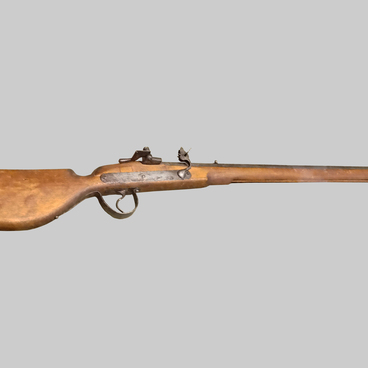The cover of the Project for Construction of the Moscow-VindAva-RYbinsk Railroad dated 1900 is displayed in the Museum. The Moscow-VindAva-RYbinsk Railroad was built in 1894-1915. The construction was carried out by a joint-stock company of the same name. The supporters of the construction of a railway in the Pskov Governorate were Prince Aleksandr DondukOv-KorsAkov and Count Sergey StrOganov, who were interested in the construction of railroad branches to their estates in the POrkhovsky District.
The issue of the direction of the future railway was discussed by the Pskov County Governatorate. Out of all the projects, the construction of the Staraya Russa - Porkhov - Pskov line was chosen, since there were two well-known fairs in this area: Sorokinskaya in the village of Sorokin and Ashevskaya in Novorzhevsky district.
16 stations were built on the Bologoye - Pskov railway: Berezki, Karamyshevo, Podsevy, Porkhov, Dno and others. The construction was comprehensive. They built not only the tracks themselves, but also all the services necessary for its operation: track facilities with stations and crossings, communication services, water supply with water pumps and water towers, traction services with locomotive and carriage depots, houses for workers with gardens and parks. One-story wooden railway stations were also built according to a standard project.
In November 1897, passenger and freight trains began to run along the section from the Pskov station, on the Pskov-Riga railway route, to the Bologoye station. The total length of the route was 335 versts.
Pskov became a large railway hub. The joint-stock company of the Moscow-Vindava-Rybinsk railway promised to build the Saint Petersburg-Vitebsk railway through the Dno and Novosokolniki stations. In 1901, traffic to the Novosokolniki station was opened, and in 1904 traffic began from Novosokolniki to the Vitebsk station.
In the fall of 1906, after the construction of the Bologoye-Velikiye Luki-Volnovyssk line, the Velikie Luki station became a junction for the Moscow-Vindava-Rybinsk and Nikolaev railways. Passenger and commercial steam locomotives of the Kolomenskoye, Putilov, Borsig and Stewart factories operated on the railway.
The rail cars were illuminated mainly with candles. Telegraph lines were laid out for communication, and a government telegraph office was located at the VelIkiye LUki station. The last line built by the joint-stock company of the Moscow-Vindava-Rybinsk railway in the Pskov Governorate was the Gdov-Pskov-Polotsk lateral railway. It was laid out since 1915 for the needs of the Northern Front. This railway was destroyed during World War II and was no longer restored due to its unprofitability.
Most railway lines built in the Pskov Governorate belonged to the joint-stock company of the Moscow-Vindava-Rybinsk railway. Currently, they all belong to the OktyAbrskaya Railroad.
The issue of the direction of the future railway was discussed by the Pskov County Governatorate. Out of all the projects, the construction of the Staraya Russa - Porkhov - Pskov line was chosen, since there were two well-known fairs in this area: Sorokinskaya in the village of Sorokin and Ashevskaya in Novorzhevsky district.
16 stations were built on the Bologoye - Pskov railway: Berezki, Karamyshevo, Podsevy, Porkhov, Dno and others. The construction was comprehensive. They built not only the tracks themselves, but also all the services necessary for its operation: track facilities with stations and crossings, communication services, water supply with water pumps and water towers, traction services with locomotive and carriage depots, houses for workers with gardens and parks. One-story wooden railway stations were also built according to a standard project.
In November 1897, passenger and freight trains began to run along the section from the Pskov station, on the Pskov-Riga railway route, to the Bologoye station. The total length of the route was 335 versts.
Pskov became a large railway hub. The joint-stock company of the Moscow-Vindava-Rybinsk railway promised to build the Saint Petersburg-Vitebsk railway through the Dno and Novosokolniki stations. In 1901, traffic to the Novosokolniki station was opened, and in 1904 traffic began from Novosokolniki to the Vitebsk station.
In the fall of 1906, after the construction of the Bologoye-Velikiye Luki-Volnovyssk line, the Velikie Luki station became a junction for the Moscow-Vindava-Rybinsk and Nikolaev railways. Passenger and commercial steam locomotives of the Kolomenskoye, Putilov, Borsig and Stewart factories operated on the railway.
The rail cars were illuminated mainly with candles. Telegraph lines were laid out for communication, and a government telegraph office was located at the VelIkiye LUki station. The last line built by the joint-stock company of the Moscow-Vindava-Rybinsk railway in the Pskov Governorate was the Gdov-Pskov-Polotsk lateral railway. It was laid out since 1915 for the needs of the Northern Front. This railway was destroyed during World War II and was no longer restored due to its unprofitability.
Most railway lines built in the Pskov Governorate belonged to the joint-stock company of the Moscow-Vindava-Rybinsk railway. Currently, they all belong to the OktyAbrskaya Railroad.



